I wrote about how I was feeling overwhelmed with a puppy.
And then I received all these nice comments on how it gets easier and your puppy doesn’t have to be perfect and so on.
Only … my main concern at the time was actually my senior dog Ace!
I was worried my older dog was being too aggressive with my puppy when resources were involved like his dog bed, toys or … ME.
My adult dog is aggressive to my new puppy
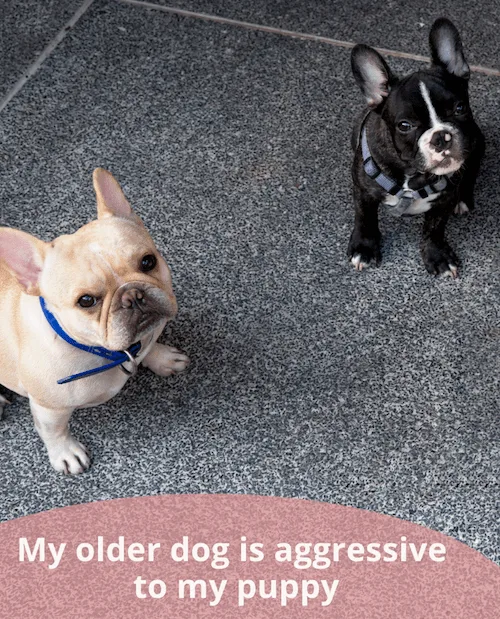
Don’t force interactions between your dog and puppy
Don’t get me wrong, it’s totally normal for an older dog to correct a rambunctious puppy. You can bet the older dog will growl or snarl or even lunge if a puppy is being a pest.
This is how a puppy learns it’s rude to jump on a dog’s head while he’s resting, for example.
The older dog shouldn’t be scolded for growling as long as he’s not physically hurting the puppy.
(Some puppies will yelp and squeal even if they are not hurt. I don’t react to this.)
Some dogs become good friends, others remain indifferent
You can try to encourage your two dogs to play, and you can take them on walks together or car rides. Plus, I’m sure you’ll all hang out together in the evenings watching TV or whatever.
I am lucky to work from home, and when we got our puppy Remy, it worked well to have both dogs in my office with me – one loose and one in a crate. That way they got to be around each other but with no pressure to interact.
I recommend you let the dogs interact at their own comfort levels. And always separate them when you’re not home.
It’s the dog owner’s job to redirect the puppy away from the older dog
The dog owner needs to make sure to redirect the puppy from being a pest so the older dog doesn’t have to correct the puppy most of the time. Call it a team effort for setting boundaries.
That being said, make sure you give your dogs time away from each other.
When we get our Lab puppy, I will do a lot of walks with both dogs together to save time. But, I also want the puppy to learn to be OK left home alone.
I think this is a mistake some people make – they have the puppy with the older dog all the time and then the puppy yowls and cries when separated from the other dog.
To prevent this, I will leave the puppy alone right away from Day 1. It might only be for 10 or 20 minutes, but the puppy needs to learn that sometimes I take my adult dog for a run without him.
Or sometimes we all leave to run errands or whatever it may be.
Remy is fine when I leave him alone – no separation anxiety. Probably because he was left a lot right from the start. I would crate him and take my senior dog Ace out for slow walks.
*If you just got a new puppy, download my free puppy training guide. Click Here
Watch for your dog resource guarding
My older dog Ace is definitely showing some resource guarding around his bed, toys and, unfortunately, ME.
This is to be expected, to some degree. If a dog is calmly chewing on a bone, he’s going to growl if a puppy barges over to take it. Again, it’s always the owner’s job to manage these interactions.
However, in my opinion, my older dog Ace has crossed a line a couple of times. (And this still falls on me as the owner. Dogs are dogs.)
Watch for potential possessiveness of anything such as food & water bowls, toys & bones, dog beds & crates, family members, other pets, furniture – could be anything!
My dog Ace showed terrible resource guarding issues when we got our puppy Remy. Ace would let out a ferocious snarl and lunge if Remy went near a toy or a bowl or even … me, sadly.
He even bit Remy on the head one time, which of course was my fault for putting them in this situation.
Thankfully, Remy is more of a “snatch and grab” kind of resource guard. Meaning, he will take the item and move away with it. He does not want to start a fight.
But, this is still aggression because he growls and raises his hackles when he does this. I’m working with him on this daily but I see it will be a lifelong issue for Remy.
So, I’ll need to manage their interactions closely around toys, bowls and dog beds. We should all be doing this anyway with new dogs, even if they’ve never shown issues with guarding anything.
I like to feed dogs in separate areas (such as their crates) anyway for less chaos. Certain toys will need to be enjoyed separately, same with rawhides, chews, etc.
I’m not sure if Remy will guard his dog bed. He’s never guarded it from us or our cat but you never know.
How to stop your older dog from being aggressive to the new puppy
Should I let my older dog growl at my puppy? Well, in some cases a little growling is good, but my older dog’s aggression towards my new puppy is more than what I find acceptable.
One example was when I was sitting on the floor petting Ace and he lunged at my puppy Remy for approaching us.
Ace used teeth on Remy’s head for a second and left marks (no punctures or scratches). Remy squealed and ran away.
I should have seen this coming and blocked Remy because, let’s be honest, he was BARGING his way onto my lap.
However, I thought Ace’s reaction was out of line.
It left me really stressed out about how I’m going to manage future interactions between my older dog and my puppy.
But on the plus side, Remy is totally fine. He’s happy go lucky and resilient. He likes Ace and he is not afraid of Ace in the slightest. They do have positive interactions with each other every day.
Other notes about Ace:
- He has been sick for 7 months and has some pain. He’s also had to wear a cone collar which blocks his vision, hearing and movement.
- I have seen some minor resource guarding from Ace over the years (Behavioral issues are rarely “out of nowhere.”)
- Since he’s been sick, Ace has shown increased resource guarding around my cat Beamer, so it’s not just the puppy.
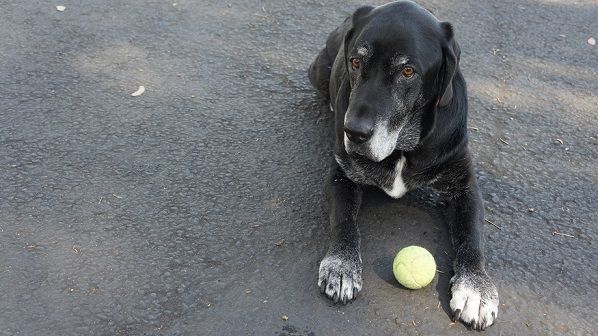
Here are my recommendations for introducing dogs that will be living together.
In our case, these have helped things go as smoothly as possible for managing two dogs of different “generations.” Update: Unfortunately our senior dog has now passed away but the two dogs did learn to get along just fine!
1. Introduce your older dog to your new dog slowly
That goes for the initial meeting but also the next couple of days and weeks. Slowly integrate them into each other’s lives. Don’t force them to play, interact, cuddle, pose for photos, etc.
It’s usually best to introduce two new dogs in a neutral area such as a park or at the very least, out in the front yard vs. the entryway of your house.
If you’re in a more neutral area, there’s less likelihood for the adult dog to feel possessive or protective. With such a young puppy, this is less of a concern. The adult dog will naturally know the pup is just a baby.
Do your best to keep things fun and positive for your older dog! Praise him for being friendly and gentle or having loose body language.
You do want to avoid areas heavily trafficked with dogs such as dog parks for now because your puppy won’t have all her shots yet. Plus, obviously you don’t want a bunch of random dogs and their owners barging up and interfering.
The two dogs may or may not choose to interact naturally, but don’t force them to be best friends.
Pick up all dog toys, bones, Kongs, food bowls, etc. Don’t give them opportunities to fight or guard these items.
It’s wise not to sit on the ground petting one dog if there is any risk of “guarding” like my example with Ace. Use gates, crates and leashes as needed.
*If you just got a new puppy, download my free puppy training guide. Click Here
3. Redirect the puppy away from your older dog
The new puppy should not be allowed to bother the older dog. The older dog needs to know you have his back.
4. Seek out positive experiences between the two dogs.
Do walks go well? Go for lots and lots of walks together as a pack if possible. Bring another adult along to help.
My dog Ace does much better with Remy when we’re outside. He tolerates Remy getting in his face for the most part as long as we’re outside.
They can walk together, sniff the same bushes and touch noses. I’m using that to create positive interactions. “Yay! Such good boys! Treats for all!”
5. Calmly have both dogs sit and then give them treats.
Dog Behaviorist Dr. Patricia McConnell has an excellent post on dog-to-dog resource guarding.
One idea she listed is to give both dogs treats one after the other for calm behavior. This is assuming you have no tension between the dogs and there is no risk of fighting while they’re sitting there.
In our case this works really well. I use a spoon of peanut butter, have both dogs sit (Remy tethered) and say their names one after the other giving them a few licks rotating back and forth.
It teaches Remy to stay and teaches Ace fun things happen around Remy.
6. Dog genders that work best together:
- One male and one female dog generally have the least likelihood for conflict
- Male to male is the next best combo
- Female to female dogs are the most likely to have conflict
This doesn’t mean you can’t have two females or that your male and female will get along. Every dog is different.
How to get your older dog to accept your puppy
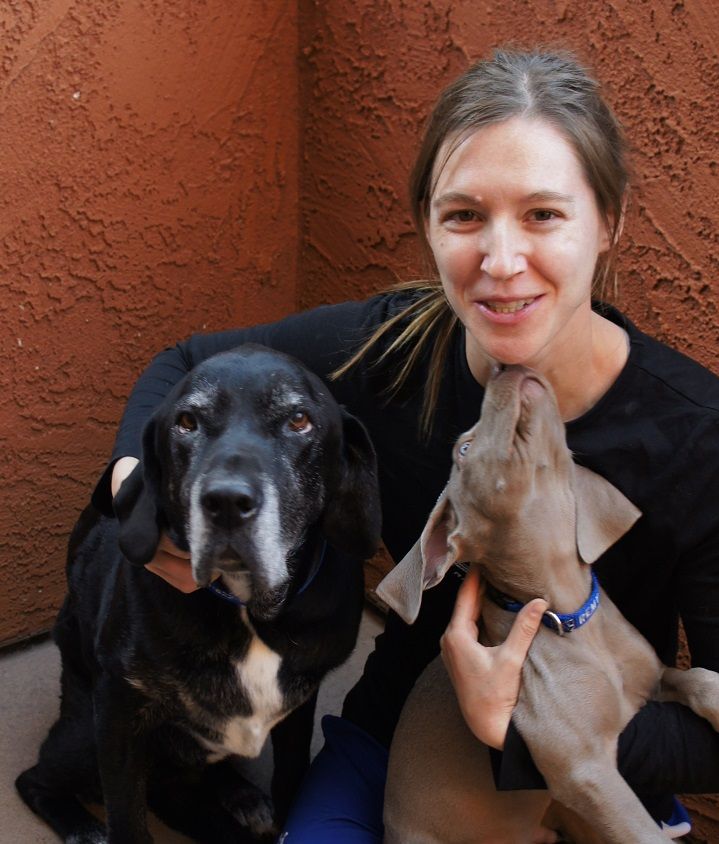
1. Dogs really do live in the moment.
Even if they fight or bite they generally move on from second to second. They can have many positive interactions on any given day.
2. Dogs adapt.
Even if two dogs have had a couple of bad interactions they can move on and live peacefully together if they’re set up for success. Usually anyway. There are exceptions.
3. Humans need to move on too.
Dog owners have to move on and change their mindsets as well. Even if something bad has occurred, you have to move on.
For example, I need to stay light and positive (not tense). I can’t sit there predicting a reaction from Ace or it’s bound to happen. I may even cause a reaction.
4. It’s not personal.
My older dog is aggressive to my new puppy, but Ace is not capable of “hating” Remy or being upset with me for getting a new dog.
Those are human emotions. My dog is just being a dog, guarding what he feels is valuable and protecting his space. While we can make it complicated, it’s really pretty simple.
*If you just got a new puppy, download my free puppy training guide. Click Here
How long does it take an older dog to get used to a puppy?
It just depends on the dogs. In our case, things got a lot better once our puppy was about 5 months old. At that age, he was large enough where I wasn’t so worried my older dog would hurt him.
And, at that age my puppy seemed to have more common sense and awareness about my older dog’s limits.
My puppy would still push the limits, but he understood there would be consequences such as a ferocious growl or a snap. He knew to “proceed with caution.”
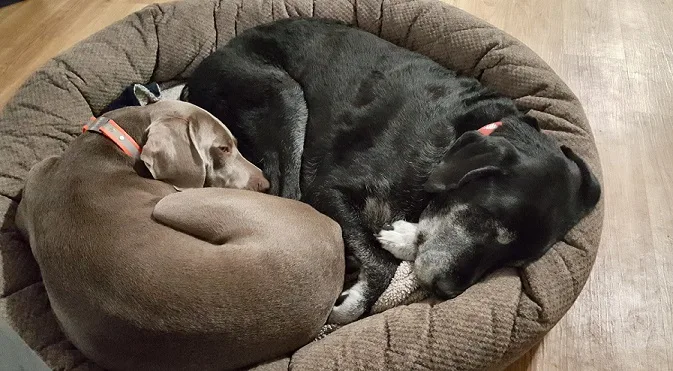
I still supervised them, of course, but I wasn’t as worried my puppy would get hurt. Around this time, my older dog seemed to have accepted our puppy and was pretty indifferent to him as long as the pup left him alone.
Then, once my puppy hit about 18 months old, they would even nap together on the same bed.
This was not because they were good friends but because my older dog would be sound asleep and Remy would sneak in for a cuddle. Once Ace woke up with Remy right there, he seemed to tolerate it as long as Remy was calm and quiet.
Other things to consider …
Change your routine ahead of time
Dogs are also sensitive to routine, and obviously your dog’s routine will be disrupted at least a little when the puppy arrives.
We can’t predict everything, but try to think ahead and start making some of these adjustments before you get your puppy.
For example, when I got Remy, Ace was used to being fed and walked as soon as I woke up. But when we got puppy Remy, I would take the puppy outside immediately and walk Ace second.
To plan for this, I adjusted Ace’s schedule before we got the puppy so he was already used to the new routine.
Example schedule for new puppy:
- 5:30am: Rise and shine, feed the dogs in crates, quick potty break.
- 6: Walk each dog separately or together
- 8-10: Dogs downtime while I work from home (crate as needed).
- 10: Puppy potty break.
- 10:15 to 11:30: Dogs downtime while I work (crate as needed)
- 11:30: Dogs potty break, lunchtime for me
- 12:30: Walk or playtime
- 1:30-3: Dog downtime while I work (crate as needed)
- 3: puppy potty break
- 4:30: Potty break & feed dogs
- 4:30 to 10:30: Hang out all evening, potty breaks as needed
- 10:30: Final potty break & puppy crated for the night
Remy was able to hold it from about 10:30pm to 6:00am as an 8-week-old puppy so I’m hoping our lab puppy will be able to as well! Some puppies need a potty break in the middle of the night.
Kennel train your puppy
I know kennel training is not for everyone but man I don’t think I could put up with a puppy if I didn’t have a crate! I plan to start kennel training immediately.
Heck, I think I’ll ask the breeder to start introducing my puppy to a kennel if she’s willing to do that before I even meet my puppy!
With our new pup, I plan to have a crate upstairs in the living room and a second crate downstairs in my office so we always have a safe place to confine the puppy or to separate the two dogs when they’re getting too rowdy.
Remy is crate trained too.
Puppies need to learn boundaries
Now, I also want to say that it IS totally normal for an adult dog to set boundaries with a puppy, within reason.
So you don’t want to correct your older dog for growling/barking at the pup when the puppy is being out of line. I know it’s hard to tell sometimes what is appropriate and what isn’t. A trainer can help you if you need advice.
Example of appropriate growling: The older dog is relaxing calmly on his bed. The puppy runs over and starts biting at his ears and climbing on his back. The older dog stiffens, then growls.
In the above scenario, try to re-direct the puppy before he starts to bite and annoy your older dog by calling to him or offering a toy. He needs to learn boundaries and self-control. Help your older dog understand that you have his back.
Example of inappropriate growling, in my opinion: The older dog is relaxing on the floor with a person kneeling next to him. The puppy walks across the room, crossing in front of the older dog with plenty of space and focused on heading elsewhere. The older dog lunges and snarls at the puppy.
In this case, I would say something like, “Oh no” or “What was that?” to show disapproval and then move towards the older dog to back him away or turn my back to him.
Then I would know I need to take it back a step and give my older dog more space away from the puppy while I work on desensitizing him to having the puppy around his resources.
Keep in mind, sometimes all you need is time. There is an adjustment period. Which brings me to …
How will you deal with your dogs’ constant roughhousing and playing?
I really do not want the dogs playing constantly in the house, so I’m going to have to be strategic with rules. Do you think it’s possible to train them only to roughhouse outside or in the garage? Sounds like a challenge.
We don’t have a fenced yard. We do have a large, heated garage with horse mats down that they can run around on and wrestle.
The crates and gates will be important for separating them. Remy knows “go to your bed” and “stay” really well, so that will be important to teach the puppy as soon as possible.
I don’t mind a little gentle “silent wrestling” in the house but the constant full-on roughhousing – no.
Consider doggy daycare
Our dog daycare offers a “puppy playroom” program specifically for puppies to play with other puppies. They work on training a bit with them and introducing them to new things. They also have “nap times.” I plan to take advantage of this at least one day a week!
A trainer we’ve worked with has a training space right next door to the daycare and she will go pick up the puppy and train him for 30 mins by appointment. I will have to take advantage of that too!
I’m not sure if I’ll also bring Remy to the daycare (to play with the other adult dogs) or if he’d prefer a day at home without the puppy. We’ll see.
See my post: Is dog daycare a good idea?
So those are my tips!
What do the rest of you have to add to this?
I love hearing from you! Let me know your experience or concerns in the comments.
*If you just got a new puppy, download my free puppy training guide. Click Here
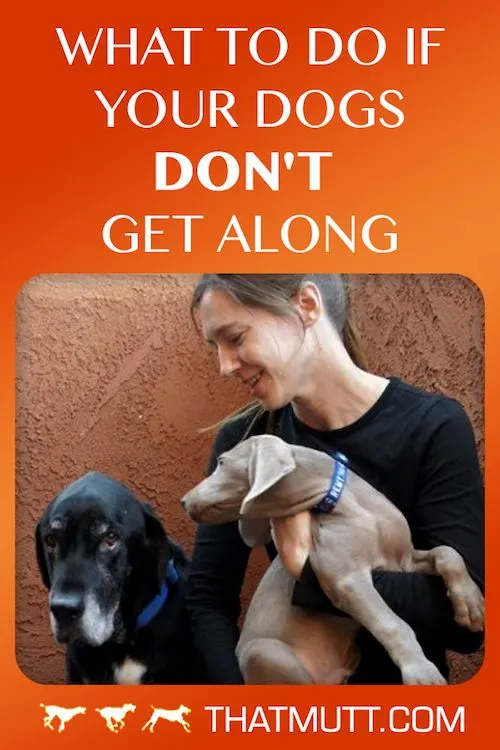
Some of my favorite dog products:
- Wellness treats.
Wellness Well Bites are treats almost all dogs are willing to work for and focus on! - Treat bag.
Carry your treats in a convenient treat pouch around your waist so you’re always ready to reward your dog for heeling, coming when called or paying attention to you. - Gentle Leader.
A Gentle Leader helps a lot of dogs learn not to pull on the leash. - The Farmer’s Dog.
My dogs eat fresh food delivered to our door from The Farmer’s Dog. Get 50% off your first order.
Other resources:
- How to prevent fights between your dogs (Ace & Remy update!)
- How to introduce dogs
- I regret getting a puppy
- How much resource guarding to allow?
- My dog growls at other dogs
- How to break a dog’s possessiveness
- Dog-to-dog resource guarding (Patricia McConnell)
Lindsay Stordahl is the founder of That Mutt. She writes about dog training, dog exercise and feeding a healthy raw diet.

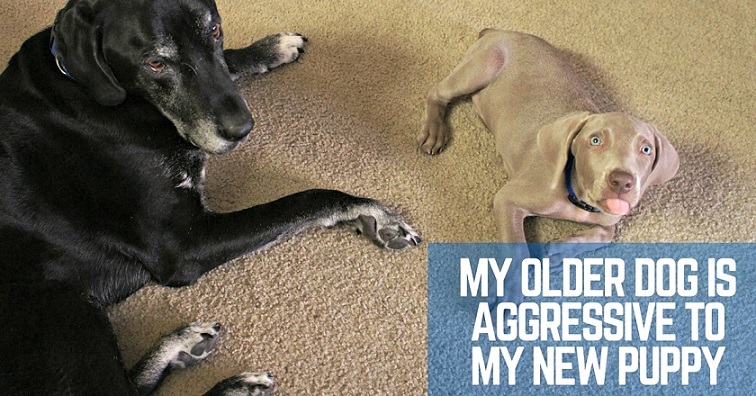
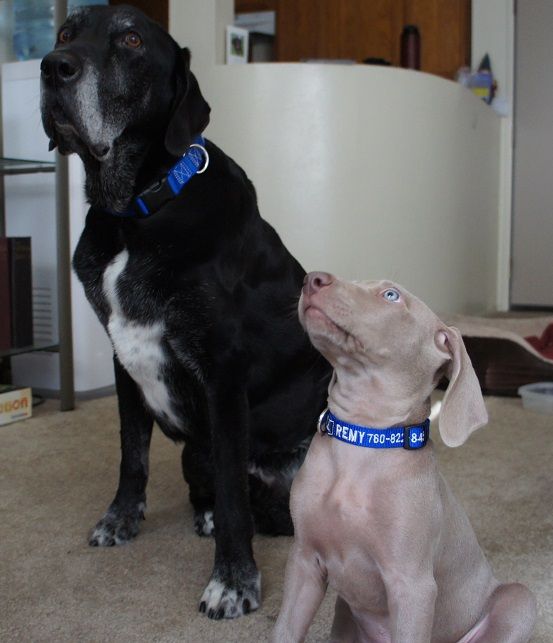
Dd
Wednesday 20th of September 2023
I don’t like putting dogs in crates and locking it. If that’s what someone loving needs to do to keep a dog it’s their biz. If you adopt a dog they’re usually crate trained. I will say that a dog can get injured need a crate so I think it’s important even if you NEVER intend to crate. Life may have other ideas. I do think it’s also a reasonable solution not overused for a dog who is well treated and well exercised and cannot calm down. I didn’t like the story of Remy barging into your lap. It’s a puppy. The rebuke was likely the dog form of jealousy or possibly just protection. It’s so common for people to get puppy with senior dog. The problem is that’s the hardest gap to bridge. And shelters get many aholes who dump senior dogs there after getting a puppy. It’s easier for dogs closer in age to get along.
Lorie
Sunday 16th of October 2022
Hello. That is a Very informative article. I have a 5 yr old female (Stella) American Staffordshire Terrior who was severely abused. I rescued her in Dec 2019. In April 2020, my son and his now ex-girlfriend rescued a lab-mixed, 2 yr old (Abby). At that time, Stella showed no aggression toward Abby. After about a year, Stella was still standoffish but would play with Abby in the yard. A few weeks ago, the ex-girlfriend took Abby when they split up, and yesterday, my son rescued another female, (Gracie) who is a boxer mixed. At the rescue, Stella and Gracie were fine walking next to each other, both on and off the leash. We get home, and Stella is now growling and lunging at Gracie. We took them on a walk this morning, and all was good. Stella was sniffing Gracie and allowed Gracie to sniff her. When we got home, Stella growled again while on the couch. Gracie was still on her lead, and my son had control of her. This time, there was no lunging or teeth showing. I know this is going to take time, but could that be a slight sign of progress? I would say to Stella, good girl, and get her attention when she started to stare at Gracie. Which helped, but it wasn't long before Stella was in her stare mood again. My Son mostly stays in the basement, but I've had him bring Gracie up (on lead) to just be around Stella. Are we going about this properly? or is there something we need to change or do? Thank you in advance for your help!
K
Monday 7th of March 2022
I have a 4 year old German shepherd/Alaskan malamute/French mastiff mix who is not dog or people friendly. The people problem his vet thinks is general anxiety as he calms down fine with a treat or some play, but his dog issues are caused by bad past experiences. When I got him I was in an area without a lot of dogs and I was only 16 and unable to take him to parks, and to be honest, just didn't really think about it because I have another dog for him to socialise with. But outside of him, the only other times he has met dogs (my brother and my cousins dogs) has ended with them attacking him and having to be pried off his neck. Not exactly encouraging. My housemate recently got a very small/underweight staffy puppy and while my dog seems curious for the most part, he is also very attached to my housemate so when he sees the puppy being held or sitting on his owners lap, he starts growling and barking, and I've had to hold his collar to stop him from possibly lunging. My dog is almost large enough to be classed as a giant breed, and the puppy at 2 months old is still only about 20 to 30 centimetres long (it was a very large litter and he was very underweight when we picked him up), so my biggest concern is that a poor interaction with have deadly consequences...
Lindsay Stordahl
Monday 7th of March 2022
Yes, you will have to be very careful, especially while the puppy is so small. I would consider a basket muzzle for your big guy. Get him used to it away from the puppy, first, using positive associations. Then you can have him wear it around the puppy to give you some peace of mind while you work on getting them used to each other. Walking them together is usually what works best for me, so they can be focused on sniffing and moving forward rather than each other. I would recommend you work with a trainer in your area in order to keep everyone safe. Good luck with the puppy.
Danielle
Monday 6th of December 2021
We just brought home a 7-week old British lab. We have an almost 2 year old lab. The older dog is showing food aggression and has bit at our puppy three times the last two days. Two of the times nothing was involved (toys, food, or us) We started feeding separately and keeping them away from each other as much as we can. Is there anything else that helps? Will it pull them further apart keeping them separated? I’m just scared she is going to hurt the tiny puppy and don’t understand what is causing it. Seems the aggression started after her first heat (she is spayed now). We had a 11 year old lab when she was a puppy that was an absolute sweetheart and passed away before we brought the new puppy home, she is the only adult dog in the house. Thank you
Kori
Friday 8th of October 2021
We have a 13 year old Maltese(Jack),a 2 year old chihuahua(Ernie) and we have a 13 week chihuahua(Dudley) also. Our 2 year old is attacking him whenever he gets a chance:( It is awful and the baby is only 2 lbs. He growls whenever he is near and the first attack he bit him and threw him.He would have continued this if I hadn't been right there:( I've tried all of your suggestions above and the baby doesn't even try and play or nip at Ernie. Ernie seeks Dudley out and this is a daily thing:( If I can try anything else I am open to suggestions:)